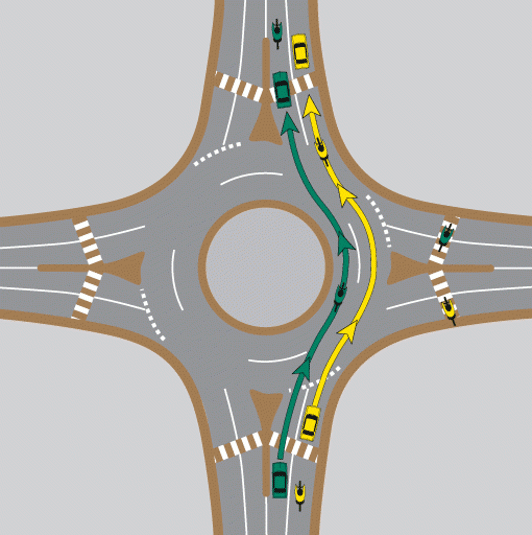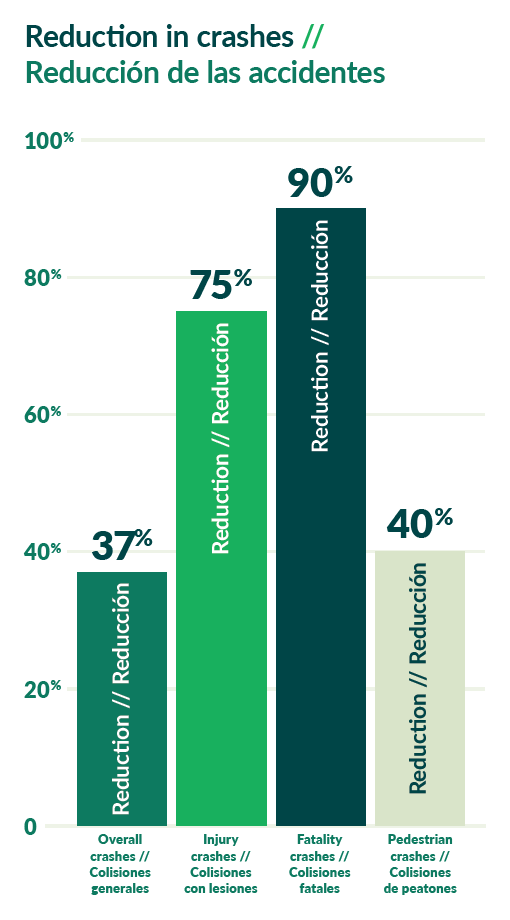Thanks to your input, we’re sharing two potential design options for this section of SR 500. Now, we’d like your feedback to help shape the final plan.
The two design options are:
- Dual-Use Shared Path – A shared use path is an area designed for use by people walking, biking, and rolling — all users share the same path
- Raised Bike Lane – A raised bike lane is a bike lane that is elevated above the roadway. In this cross section, the sidewalk and raised bike lane are separate and people biking would travel in the direction of traffic.
Both options reflect the top priorities you shared with us:
- Improving safety and accessibility
- Supporting all types of travelers—whether by car, bike, or on foot
- Reducing traffic congestion, collisions, and travel times
We’re also considering adding roundabouts at key intersections in both design options. Roundabouts can help calm traffic, improve safety, and keep vehicles flowing more efficiently.
During this open house, you’ll see:
- Cross-section graphics that show what each design would look like if you sliced through the road—think of cutting through a piece of fruit, like an orange or tomato.
- The key intersections where roundabouts are being considered.
To wrap up, we’ll ask for your thoughts on the two design options and the possible roundabouts. Your feedback will help guide the final design decisions.
New potential design elements
Roundabouts: What is a roundabout?

A roundabout is a circular intersection where drivers travel counterclockwise around a center island. There are no traffic signals or stop signs in roundabouts. Drivers entering the roundabout yield to traffic already in the roundabout, then enter the circulating roadway and exit at their desired street, so they function differently from older circular intersection types.
Roundabouts are designed to make intersections safer and more efficient for drivers, pedestrians, and bicyclists.
Studies from the Federal Highway Administration show that roundabouts can help traffic flow more efficiently, moving 30 to 50% more vehicles through the intersection than regular intersections. They also slow down traffic to around 15–20 miles per hour, which makes crashes less likely and less severe. These lower speeds help make walking, biking, and using mobility devices like wheelchairs much safer.

Roundabouts are also built to handle all types of vehicles, including emergency vehicles, buses, and large trucks with trailers.
We are exploring adding roundabouts at these intersections to help increase safety and lower speeds.
- NE 65th St
- NE 71st St
- NE 76th St

Current cross-section
This is SR 500 today: two lanes in each direction shared for driving, and a sidewalk in each direction. People biking may use either the vehicle lane or the sidewalk.

Design Alternatives
Option 1
Shared Use Path: A shared use path is an area designed for use by people walking, biking, and rolling — all users share the same path.

Features:
- Path for cyclists and those walking and rolling.
- Two vehicle lanes in each direction.
Key differences:
By using roundabouts at key intersections, we can remove the existing center turn lane, replacing it with a raised buffer with street trees between travel lanes and the bike lane.

Features:
- Path for cyclists and those walking and rolling.
- Two vehicle lanes in each direction.
Key differences:
Without adding a roundabout, this alternative keeps the existing center turn lane for vehicles to use in both directions and utilizes traffic signals to regulate the flow of traffic.
This alternative would also have a shared use path on the east side of the road from NE 76th Street to 71st Street, crosses SR 500 at 71st Street, then continues on the west side of the road from NE 71st Street to NE Fourth Plain Boulevard.
Option 2
Raised Bike Lanes and Sidewalks: A raised bike lane is a bike lane that is elevated above the roadway at the same level of the sidewalk. In this cross section, the sidewalk and raised bike lane are separate and people biking would travel in the direction of traffic.

Features:
- A raised dedicated bike lane.
- Dedicated space for people walking and biking.
- Two vehicle lanes in each direction.
Key differences:
By using roundabouts at key intersections, we can remove the existing center turn lane, replacing it with a raised buffer with street trees between travel lanes and the bike lane.

Features:
- A raised dedicated bike lane.
- Dedicated space for people walking and biking.
- Two vehicle lanes in each direction.
Key differences:
Without adding a roundabout, this alternative keeps the existing center turn lane for vehicles to use in both directions and utilizes traffic signals to regulate the flow of traffic.
